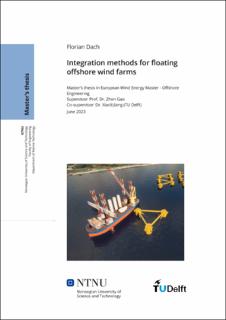| dc.description.abstract | Antallet flytende havvindparker under utvikling har økt drastisk de siste årene etter hvert som teknologien har blitt levedyktig for pre-kommersielle og kommersielle prosjekter. Prosjekter av denne størrelsen krever en strømlinjeformet og effektiv produksjon av den komplette flytende havvindmøllen, ikke bare for å produsere flyteren, men også for å montere hele systemet. De fleste monteringsoppgavene kan i teorien utføres i en havn, noe som vanligvis er å foretrekke, men de fleste havner har ikke tilstrekkelig havneinfrastruktur til å utføre disse oppgavene, og de nødvendige oppgraderingene av infrastrukturen er svært kostbare. Dette er en stor utfordring for mindre, nye flytende vindparker, som ikke har tilstrekkelig mange enheter til å forsvare de store investeringene som kreves for monteringen. For å løse dette problemet kan man bruke et oppjekkbart installasjonsfartøy nær land for å integrere vindturbinen på den flytende enheten. Dette vil sikre at prosjektet kan realiseres uten store infrastrukturinvesteringer. Samtidig vil det kunne utnytte det skjermede områdets fordeler og være et startskudd for storskalaprosjekter i regionen.
Dette foreslåtte konseptet har hittil ikke blitt undersøkt i akademisk forskning. Derfor tar denne avhandlingen sikte på å skape en generell forståelse av systemet og dets egenskaper. Med utgangspunkt i eksemplet Port Talbot i Storbritannia skal det undersøkes hvordan konseptet kan implementeres på et sted. Videre gjøres det en responsanalyse av systemet i SIMA for installasjonen med ett enkelt blad for å forstå hvilke bevegelser som kjennetegner integrasjonsoppgaven og hvilke miljøforhold som begrenser driften. Disse driftsbegrensningene implementeres deretter i en Python-modell av hele integrasjonssekvensen for å gjennomføre en driftsanalyse som også skal gi estimater for nødvendig installasjonstid og kostnader for systemet når det utsettes for vind- og bølgebelastning. Basert på resultatene av disse studiene skal konseptets tekniske og økonomiske gjennomførbarhet undersøkes.
Studien har vist at de bølgeinduserte flytebevegelsene hovedsakelig styrer systemets bevegelser under installasjonen av ett enkelt blad, noe som fører til svært strenge driftsgrenser for bølgene under sammenkoblingsprosedyren. Den tekniske gjennomførbarheten av det foreslåtte systemet er gitt hvis det ikke utsettes for stort tidevann og hvis det implementeres en tilstrekkelig kontrollmekanisme for installasjonen. Driftsanalysen har vist at systemet kan være økonomisk gjennomførbart hvis mindre prosjekter skal gjennomføres. For store prosjekter er det sannsynligvis mer gjennomførbart å investere i havneinfrastrukturen.
Alle skript og modeller som er brukt, finner du på https://github.com/Fl0tastic/FDachMasterThesis.
Nøkkelord: Flytende offshore vindturbin, Vindturbinintegrasjon, Havneinfrastruktur, Turbinmontering, Installasjon av enkeltblad, Installasjonsfartøy for vindturbin, Jack-up-fartøy, Responsanalyse, Operasjonelle grenser, Operabilitetsanalyse, Installasjon av vindpark, Offshore vind | |
| dc.description.abstract | The amount of floating offshore wind farms under development has drastically increased over the
past years as the technology becomes viable for pre-commercial and commercial scale projects.
Projects of this size require a streamlined, efficient production of the complete floating offshore
wind turbine (FOWT), not only for manufacturing the floater but also for assembling the complete
system. Most assembly tasks could, in theory, take place in a port, which is generally preferred,
but most ports do not have the sufficient port infrastructure to perform those tasks, while the
required infrastructure upgrades are very expensive. This is a significant challenge for smallerscale,
first-mover floating wind farms, which do not have sufficient units to justify those substantial
investments for the assembly. To overcome this issue, a jack-up type wind turbine installation
vessel could be used nearshore to integrate the wind turbine on the floating unit. This would
ensure the realisation of the project without major infrastructure investments. At the same time,
it could utilise the sheltered area’s advantages and be a kick-off for large-scale projects in the region.
This proposed concept has so far not been investigated in academic research. Therefore, this
thesis aims to create a general understanding of the system and its characteristics. Based on the
example of Port Talbot in the UK, it should be examined how the concept can be implemented in
a location. Furthermore, a response analysis of the system is done in SIMA for the single blade
installation to understand which motions characterise the integration task and which environmental
conditions limit the operation. Those operational limits are then implemented in a Python model
of the complete integration sequence to conduct an operability analysis which should also give estimates
for the required installation time and costs of the system when subject to wind and wave
loads. Based on the findings of those studies, the technical and economic feasibility of the concept
should be investigated.
The study has found that the wave-induced floater motions are mainly governing the systems
motions during the single blade installation, which leads to very strict operational limits for the
waves during the mating procedure. The technical feasibility of the proposed system is given if it is
not subject to large tides and if a sufficient control mechanism is implemented for the installation.
The operability analysis has shown that the system can be economically feasible if smaller projects
should be implemented. For large projects, it likely more feasible to invest into the port infrastructure.
Keywords: Floating offshore wind turbine, Wind turbine integration, Port infrastructure, Turbine
assembly, Single blade installation, Wind turbine installation vessel, Jack-up vessel, Response
analysis, Operational limits, Operability analysis, Wind farm installation, Offshore wind | |
